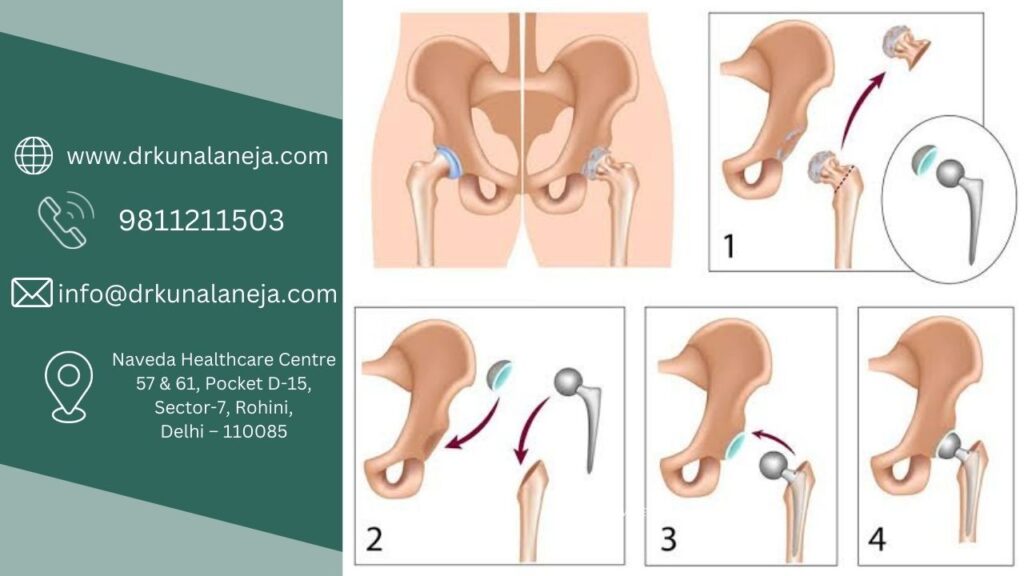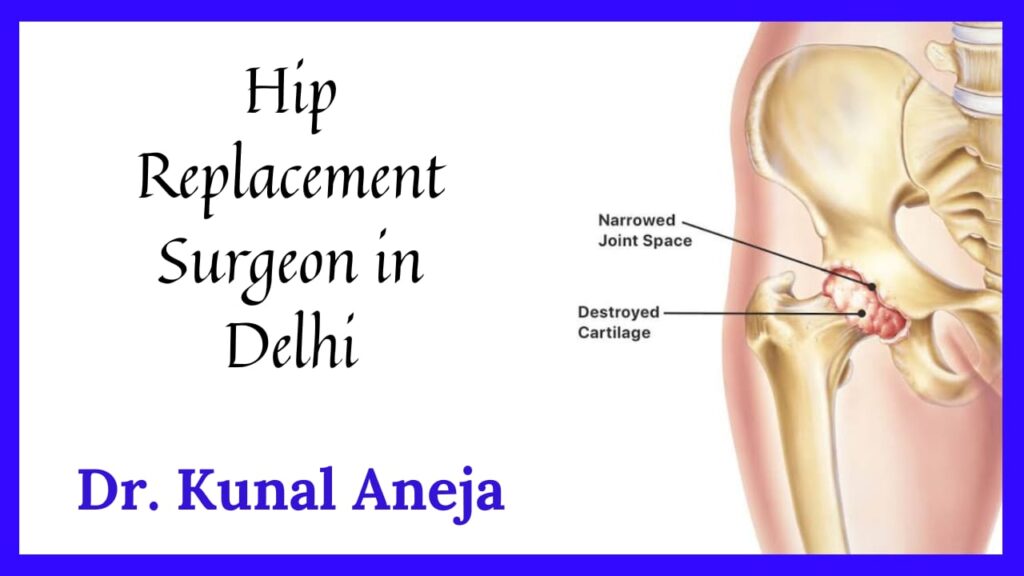
Best Hip Replacement In Rohini by Dr. Kunal
In Delhi, Dr. Kunal Aneja is one of the best hip replacement surgeons
The article will help you find out the advantages and drawbacks of total hip replacement surgery if you have just begun thinking about different treatment options, or have already decided to have your hip replaced by a Hip Replacement Surgeon in Rohini. This article will now explain:
How do normal hips function?
- Hip pain causes
- How does hip replacement surgery work?
- Getting back to your regular routine can be made easier by exercising and doing activities that can assist in regaining strength and mobility
It may be difficult to walk, or get into and out of a seat, if your hip is injured due to a fracture, arthritis, or other condition. You may have stiff hips, and you may find it difficult to wear your socks and shoes. You may have difficulty resting.
It is important to note that you should consider hip replacement surgery if you fail to find relief from your pain with medications, changes to your routine activities, and the use of walk support. When you have a hip replacement, you will be able to ease your pain, increase your mobility and return to your regular activities once you have had a hip replacement procedure.
Among the most common medical procedures that have been performed is the hip replacement procedure, one of the most successful. The effectiveness of total hip replacement surgery has been significantly improved since the 1960s, due to advancements in joint-replacement surgery and technologies. It is estimated that more than four million hip replacements are carried out in the U.S. annually based on the data provided by the Agency for Healthcare Research and Quality.
What is anatomy?
In the body, the hip is a joint that forms an acetabulum (the top end of the pelvis bone) and a ball that forms the top end of the femur (the thighbone). As well as being one of the most significant joints, it is a joint that creates a socket by forming the acetabulum.
A cushion between the edges of the bone surfaces just below the articular cartilage protects the bones when the socket and ball are moving, allowing these parts to move freely since cartilage articular surrounds the edges of the bones. As a result, the joints are able to move freely thanks to cartilage articular.
The synovial membrane is a thin, slender tissue that surrounds the joint of your hip. When the synovial membrane is in good health, it provides a tiny amount of fluid that assists the cartilage in lubricating itself and reduces friction between the cartilage and the surrounding bone.
There are a number of reasons why hips hurt
Arthritis, which can be caused by a number of factors, is one of the most common causes of chronic hip discomfort and disability. Rheumatoid arthritis is the most common form of the disease, followed by osteoarthritis and traumatized arthritis.
Rheumatoid arthritis, osteoarthritis, and traumatized arthritis are all some of the most common types of arthritis and contribute to chronic hip discomfort and disability. These types of arthritis are caused by a variety of factors, but are most often caused by rheumatoid arthritis, which is the most common type of the disease.
Age-related arthritis causes wear and tear to the hip bones. Osteoarthritis is a condition that typically affects people over the age of 50, though it is more common in those who have previously suffered from arthritis. It is caused by the wear and tear on the cartilage, which causes the bones to collide, leading to hip stiffness and discomfort. Osteoarthritis may be triggered or intensified by subtle differences in the way the hip develops when it first begins to develop.
The cartilage of the hip can be damaged by a serious hip injury or a fracture, resulting in stiffness and hip pain over time.

There is a possibility of osteonecrosis (also sometimes referred to as necrosis vascular) when there is a lack of blood flow to the head of the femoral bone as a result of a hip fracture or dislocation. Osteonecrosis occurs when the surface of a bone breaks down as a result of a lack of blood. Additionally, certain diseases can cause osteonecrosis to occur.
Children who suffer from hip problems are more likely to have this condition later on in their lifetime, even though the hip problems are initially well treated in early childhood. This is because your hip might not develop as you would expect it to, and your joints might be affected.
Description
Complete hip replacement (also called the total hip joint) refers to the removal of the damaged cartilage and bone of the hip joint and the replacement of those parts with prosthetic ones.
- This procedure involves removing the damaged part of the femur’s head and replacing its elements with a metal stem that is inserted inside the hollow center of the femur, which can either be cement-based or part of a “press to fit” procedure.
- In order to replace the damaged head of the femur, a ceramic or metal ball is placed on the stem’s upper portion.
- This procedure involves removing the cartilage surface on the socket (acetabulum) that has been damaged and replacing it with a metal socket made from materials such as cement or screws. The socket must be retained in the right position using cement or screws.
- Between the ball that is being replaced and the socket, a ceramic, plastic, or metal spacer is put in order to create a smooth, smooth surface between the ball and the socket that will be replaced.
Is Hip Replacement Surgery right for you?
It is important that your family, your primary physician, your orthopaedic physician, and your primary care physician all participate in the decision to undergo hip replacement surgery. In most cases, the decision is made after your physician refers you to an orthopaedic surgeon for an initial examination.
Surgical recommendations
Hip replacement surgery can be recommended for a number of reasons, among which are: If you are suffering from a number of the following conditions, you might be a good candidate for hip replacement surgery.
- A hip pain that restricts daily things, such as walking or the ability to bend
- Hip pain that persists while taking a break, in the morning or at night.
- The stiffness of the hip restricts the ability of the leg to lift or move the leg.
- Insufficient pain relief with anti-inflammatory medicines physical therapy, walking aids

Surgery candidates
A total hip replacement can be performed at any age or weight.
Patients are evaluated on a case-by-case basis for their disability and pain, not their age. In general, orthopaedic surgeons evaluate patients individually based on their disability and pain. The majority of people who undergo a total hip replacement are between the ages of 50 and 80. A hip replacement with a total hip can be performed successfully for a wide range of ages, beginning with young adolescents with juvenile arthritis and continuing into the elderly with degenerative arthritis, all of which are successful.
content by best healthcare marketing agency

